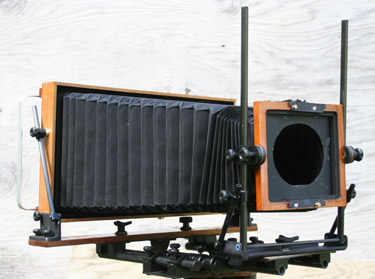
7 x 17 camera in horizontal position

7 x 17 camera in vertical position
|
|
|
|
Film Speed Test |
BTW, I just finished watching the owner's manual that comes with Richard Ritter cameras. Very informative and I learned a bunch of things about the camera that were not evident at first glance. Definitely a lot of thoughtful engineering went into this camera, and more, the fact that the designer was a real photographer with experience with this size camera really shows in the small details.
Wow!! I have to say that this camera has fully met my expectations in terms of its specifications for movements, weight, rigidity and bellows draw. One kick-ass 20X24 camera IMHO.
|
|
|
|
How does one get to where one is today? I now see that I started my repair and design career 25 years ago with the training I received in the machine tool industry. I have a degree in Tool & Die design and worked as a Tool & Die maker. The company I worked for made custom machine tools, and did work for Bell Labs. The people I worked under were true masters at what they did. Here I sit today having worked at Zone VI Studios for 14 years, and now on my own servicing the large format and the Ultra large format fields. I also have developed a passion for camera collecting and the history of the industry. As a result I am doing conservation work for collectors, and have been able to study cameras built before 1900. This was a time when there were barely any cameras in existence. In this time period a lot of different designs were tried. Some worked great, but were short-lived. Add to all this that I am also a photographer that likes to work with large cameras in the middle of Vermont winters. | |||
|
In working on Ulf cameras in the sizes of 7 x 17, 8 x 20, and 12 x 20, there were always complaints about the new and used cameras that were available. On used cameras people wanted less play in the standards, and they wanted to have front movements (most had none). On the older cameras the rails were wood with slots that had a strip of metal holding the standards snug to the rails. After years of use these cameras developed slop in the slots that allowed the front and rear standards to wiggle. Even some modern-made cameras have rail slop. I also noticed that most camera makers today are following field camera designs that were started 75 years ago. The materials have changed in some cameras, but not the design. When I started on my camera, it was for myself and no rules had to be followed. It had to have the following criteria: Light weight, strong, movements front and rear, and rigid when the rails were locked. To get to what I wanted, I pulled out an old design I had made for a 3.5 pound 4 x 5 camera. I used ideas from it and bits and pieces from different cameras built before 1900. Then one day I was out photographing and decided to do a vertical. I ran into the same problem everyone else finds. You need a second tripod so the camera will not fall over, and a good strong head your main tripod. Trying to operate the camera also got a bit interesting. Remember how one objective was light weight? But I had to have a second tripod and a stronger tripod head, meaning heavier head, which leads to a heavier tripod... No this will not work. The camera had to be changeable from horizontal to vertical in order to keep the camera on top of the tripod, not leaning out over the side wanting to fall over. The result is a camera in the 11- to 14-pound range depending on the format size. It goes from horizontal to vertical easily. This was performed by using modern materials, such as carbon fiber tubes for the rail system, and combining them with the beauty and elegance of wood.
The camera rail system is designed to cover sizes up to 20 x 24. |
|||
|
Max. extension 865mm
34 inches of bellows Standard lens board size is 6 x 6 Deardorf style boards. |
Rear swing
Weight 7 x 17 12 pounds 8 x 20 13 pounds 12 x 20 14 pounds |
|
|
|
| |||
|
Return to home page
Gallery
Workshops For contact information
©2019 RTRitter |
|||